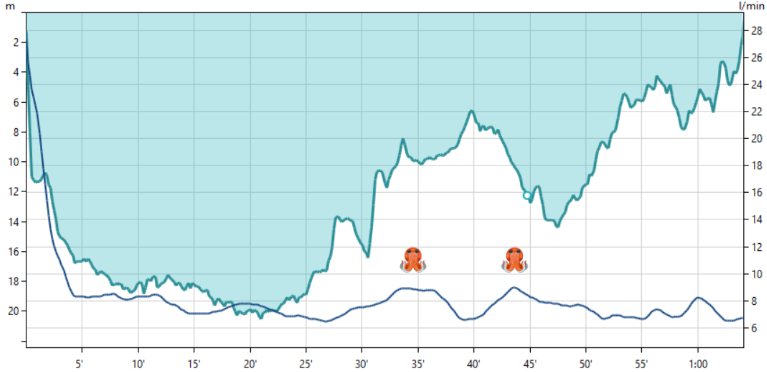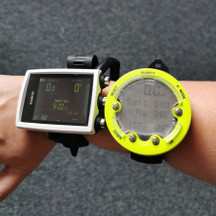Posted by Cat Jones on 10th May 2021
What is a SAC rate? Why should I care? And how can I improve it?
What is a SAC rate?
Your surface air consumption rate. It is a number that tells you how much air you consume per minute. Think of it as a bit like MPG for a car… but for you and air!
As you may remember from your Open Water classes, air becomes denser at greater depths. Therefore you consume more air the deeper you are. The maths involved normalises the air you consume to the air density at the surface. This rate is then given as litres per minute. If you have heard someone say “I’ve got a SAC of 15”, it means when normalised for the surface, they consume 15 litres of air per minute. You may also see it written as l/m.
There are several ways you can calculate your SAC rate. By far the easiest and most accurate is using the data that comes from your dive computer. If you have integrated air, many systems (such as my Suunto EON Core with Suunto Tank POD and the DM5 software) will tell you right away. Or even be able to tell you your SAC at any given moment during your dive. If you do not have integrated air, you can get a slightly less accurate but still good answer. With my Suunto Zoop Novo I manually enter my air in and air out into the DM5 software. Consult your computer manual or ask at Aquasport for help with this.If you do not have a computer, you can get your SAC by noting the air you have at a certain depth, swim at this depth for 10 minutes then make a note of your air again. With a bit of maths, you can get your SAC rate. This guide from DAN breaks this down much better than I can - http://www.alertdiver.com/?articleNo=259
Some divers think SAC rate is all about bragging rights. Diving is not a competitive sport and we focus more on safety and working with our buddies. This is where knowing your SAC can come in handy.
Knowing your SAC can help you plan your dives to an even greater level of detail and know you will still be safe with enough air. To go back to the car analogy, you know when you will run out of fuel and need to go to a petrol station. This is the same with how long before you need to surface. Especially if you are interested in technical diving as you can plan your dives to be confident you can have deco stops.
If you are in a group of divers, knowing SAC rates will help with organising buddy pairs. You can buddy with someone who will likely need to surface around the same time as you. Or if you and your buddy have very different SAC rates, you can make allowances such as giving the one with a higher rate a larger cylinder. Similarly, if you get to the dive site and find one cylinder is filled to 200 bar and the other to 220 bar, it makes sense to maximise your dive time by giving the 200 to the buddy with a lower SAC rate.
How can I improve it?
First of all - there is no such thing as an ideal SAC rate. There is no magic number every diver “should” be at.
To revisit the car analogy, there are ways you can improve your fuel consumption by changing how you drive. But there are limits to what adjustments can be made. You can get more MPG out of your 4.8 litre V8 by not revving the engine, but you will always struggle to be as efficient as a 1 litre hatchback. In the same way, there may be a limit on how much you can improve your SAC. For example, a tall, well-built gent with big lungs and muscular body is going to struggle to match a petite lady when it comes to how much air their lungs need to supply oxygen to the body.
Here are some areas to look at that could bring your SAC rate down:
Stress
You use more air when you are stressed. I personally use about 5 litres per minute more when I am on a dive working with students compared to similar recreational dives. I’m not “stressing out” as such, I just have a lot more to think about! Consider what anxieties you have whilst diving and take some steps to improve on them. Take care to focus on your breathing with long and slow deep breaths too.
“Positive stress” also has an effect. See the dive below where the dark blue line is my SAC rate (using my Suunto EON Core with integrated air pod) and the green is the dive profile. You can tell when I saw octopuses as I got excited and my SAC rate increased! If you are a new diver, the more you dive the more the good and bad stress should mellow out and bring down your SAC rate with experience.

Exertion
A dive along a reef wall against a current will mean you are exerting more energy than on a dive when you kneel on the sand and watch mantas. More exertion means your body needs more air. You can help keep this low by careful dive planning, good buddy communication to know when you are getting tired and keeping “dive fit”. Look out for articles in the future on how to improve your fitness for diving.
Your body also burns more in cold water. Make sure that your exposure protection is what it needs to be for the environment to limit the impact of this. Such as having a good quality undersuit for your drysuit or grabbing a hood and gloves to stay warm on tropical dives if you chill easily.
Streamlining and buoyancy
The ideal position for a diver in the water is horizontal with no trailing equipment and strong but steady finning technique. You would also ideally have the right amount of weight on you to limit unnecessary drag.
Take some steps to consider how you can improve your trim in the water, try out different finning techniques (frog vs butterfly) to get the most out of the energy you need to use. Don’t forget that Aquasport offers the PADI Peak Performance Buoyancy speciality that really helps you fine-tune this and bring down your SAC rate.
--
So there we have it. Hopefully you found this guide helpful. If you want a recap of the opening questions and their answers:
What is a SAC rate? How much air you use diving.
Why should I care? Safety and organisation.
How can I improve it? Consideration and practice.
See you in the water soon - Cat
